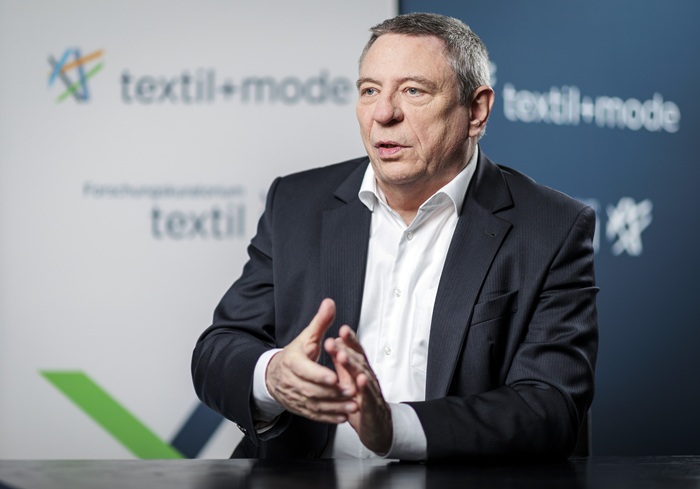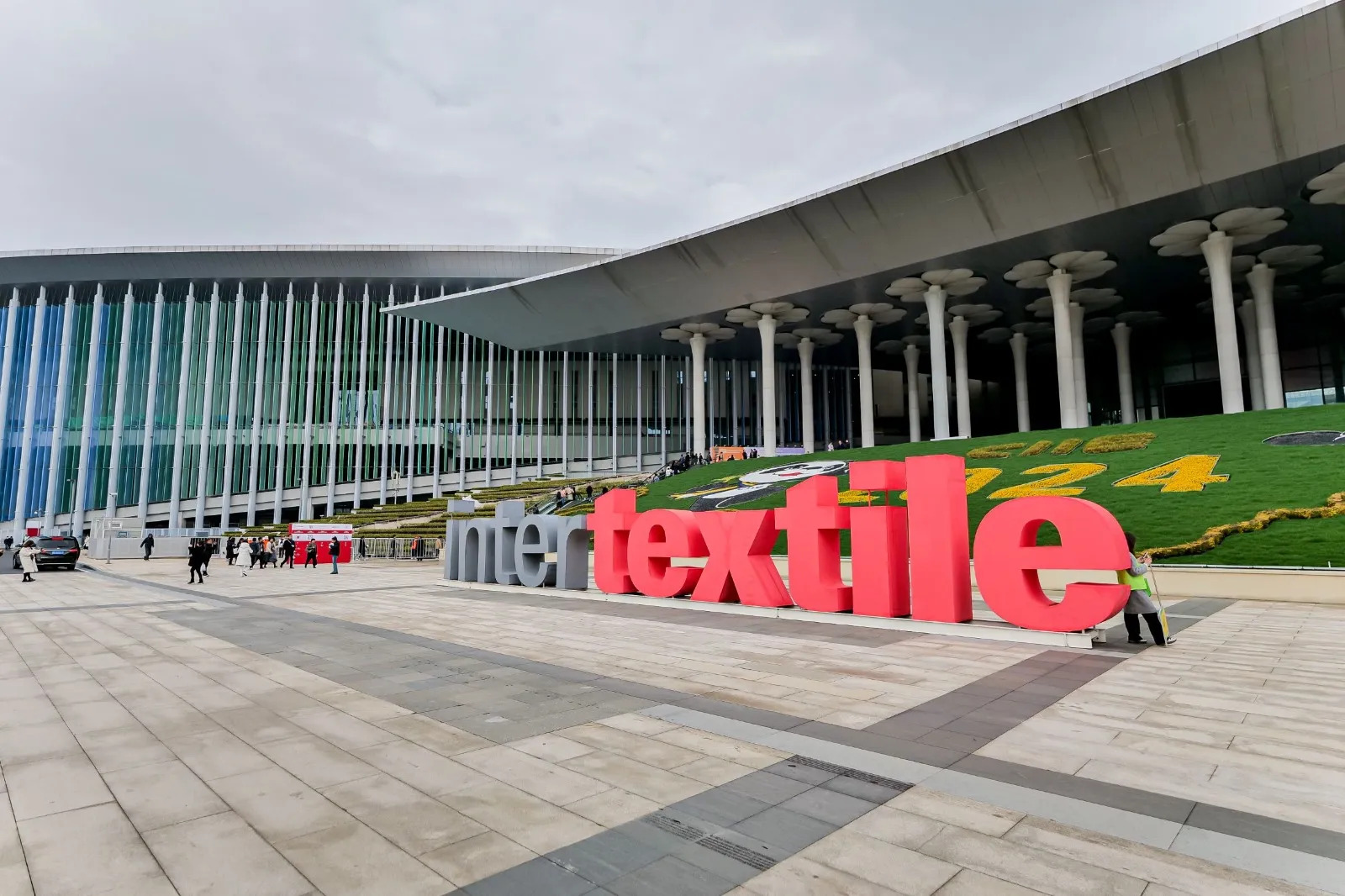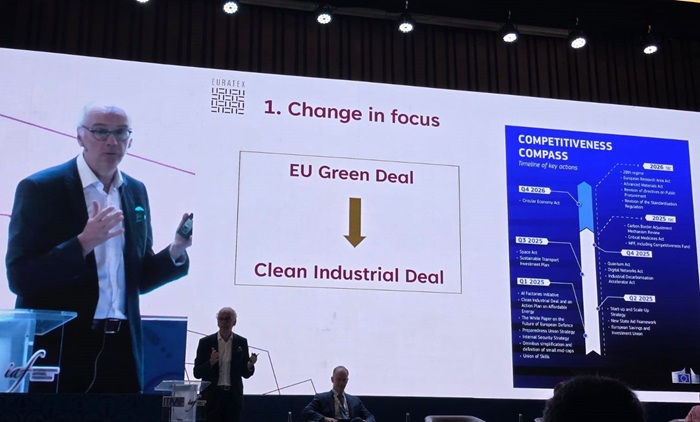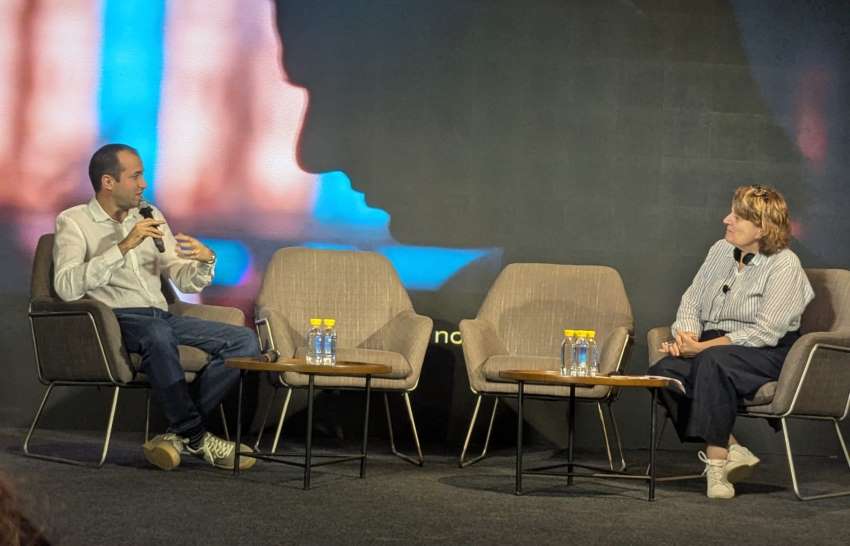FW
The Berlin tradeshow saw a wide and interesting mix of collections from streetwear to contemporary and high-end collections. The recently concluded tradeshow hosted 1,000 companies and 1,800 collections, attended by buyers and insiders from all over Europe (mainly US and Asia). Though the future of Euro and Greece is shaky, the mood was optimistic and enthusiastic. Patrick Stupp, CEO of womenswear label Rich & Royal, said that generally, buyers have lower budgets to spend on fairs. This brand, though scored almost a two-digit growth on the number of orders during the last ordering season and grew 50 per cent.
Einstein & Newton, the T-shirts only label expanded its product portfolio within the last season into full-range apparel collection for women and men. This brand, located on the outside area were providing a barbecue in a truck-booth for visitors.CEO, E&N, Mario Lipovac speaking about the tradeshow said that the label had developed into a brand for high-quality retailers that were exhibiting at Premium.
A denims show had apparels inspired by the 70’s which were a hit, outer jackets in military styles, luxury sportswear, ‘Shoendals’, a new footwear trend, wood watches in accessories and the colour orange were all a part of the show.
Now wear clothing that kills bacteria, conducts electricity, captures harmful gas, wards off malaria and weaves transistors into shirts and dresses. Researchers at Cornell University, Ithaca, NY say that they are capable of creating clothing out of cotton, which can do all this. Juan Hinestroza, Associate Professor of Fibre Science, who directs the Textiles Nanotechnology Laboratory at Cornel says that cotton is one of the most fascinating and misunderstood materials. He says that we can control cellulose-based materials one atom at a time.
Students, led by Prof Hinestroza, have turned cotton fibres into electronic components, such as transistors and thermistors. This means, instead of adding electronics to fabrics, the fabric is converted into an electronic component. The group also added conformal coatings of gold nano-particles and semi-conductive and conductive polymers to tailor the behaviour of natural cotton fibres. Prof Hinestroza explained that the layers are so thin that flexibility of the cotton fibres is always preserved.
A dress was created by Abbey Liebman using conductive cotton threads capable of charging an iPhone. With ultrathin solar panels for trim and a USB charger tucked into the waist, the garment captured enough sunshine to charge cell phones and other handheld devices, allowing the wearer to stay plugged in.
Synthesising nano-particles and attaching them to cotton, besides creating colour on fibre surfaces without the use of dyes, allows the new surfaces to efficiently kill 99.9 per cent of bacteria. This could ward off colds, flu and other diseases, state the researchers.
Textile Exchange has released the 2014 Preferred Fiber and Materials Report, which showcases an increase in the use of preferred fibers and materials. Preferred materials include recycled polyester, lyocell, organic cotton, and more.
The report says both survey results as well as textile industry studies demonstrate how preferred fibers are outpacing the growth of conventional fibers such as cotton. The report is designed as a tool to help brands, retailers, educators, nonprofit organizations and the entire textile supply chain understand the preferred fiber & materials (PFM) market.
The long-term goal is to support the growth and development of the PFM supply chain from fiber to finished product and on to the consumer. The report also challenges the textile community to address today’s market use of synthetics and encourages them to adopt more sustainable options. Textile Exchange works on a global scale to support the transition to more sustainable fiber and material options.
The report also congratulates the top 10 users of recycled polyester including Nike, The North Face, Target, H&M, Puma, Williams Sonoma, G-Star Raw, Mountain Equipment Co-op, Volcom and Prana and top five users of Lyocell - Inditex, H&M, Target, G-Star Raw and Eileen Fisher.
www.textileexchange.org
While the minimum wage increase was expected to have a negative impact, Cambodia’s garment and footwear sector is performing well, says a new International Labor Organization (ILO) bulletin. Exports in the first quarter hit $1.48 billion, nearly 8 percent increase over the first quarter of 2014 driven by strong demand by the European Union, which has overtaken the US as Cambodia’s main garment importer.
The bulletin, titled ‘Labor Standards in Global Supply Chains’, is a new quarterly publication published by the ILO using data from the Ministries of Commerce and Labor, the National Institute of Statistics, and the Cambodia Investment Board.
Last year, the garment and footwear industry grew by 9.3 percent to $5.8 billion, up from $5.3 billion in 2013. Footwear exports grew even faster, increasing by 23.9 percent to $438 million in 2014 over the previous year. As per the Cambodian Investment Board, 78 new garment and footwear factories were approved in 2014, with a total value of $452 million of fixed assets. In the first quarter of 2015, 19 more factories, worth a total of $72 million gained approval. With new factory openings, employment is on the rise. According to official figures, the total garment worker population increased from 497,200 in 2013 to 580,900 in 2014. During the first quarter, that number hit 605,100.
GMAC members were earlier worried that raising the minimum wage to $128 per month, effective last January, would make Cambodia less competitive compared to countries like Bangladesh, which has a minimum wage of $71 per month. Parts of Vietnam also have a lower minimum wage than Cambodia: $100 per month. GMAC warned of factory closures and investors moving to cheaper destinations. However, so far, this pattern hasn’t materialized. Only 11 factories closed in 2014. In the first quarter of 2015, factory openings exceeded closures by 14, said the bulletin found.
www.ilo.org
The US has renewed GSP facility for Sri Lanka. This has boosted Sri Lanka’s export development efforts. The US is the biggest consumer of Sri Lankan apparels. Sri Lankan exporters will gain duty free access for eligible products under the GSP program. The US GSP Program is in force until December 31, 2017. It provides preferential duty free entry into US market for nearly 5,000 products from 122 designated beneficiary countries and territories including Sri Lanka.
US importers are eligible to claim import duty paid by them for eligible products during the lapse in GSP coverage from July 31, 2013, with retrospective effect. Since 2010, Lankan exports to US have increased by 59 per cent. In 2014 Lankan exports to US were valued at $2.7 billion. In the same year, apparels comprised 73 per cent of Lankan exports to the US. In 2014, Lankan exports to the US rose year on year by 8 per cent in comparison to 2013.
Apart from apparels, Sri Lanka’s other leading exports to the US in 2014 were rubber tyres, plastic based packing materials, rubber gloves, activated carbon, coir products, and rubber floor coverings.
Rohit Aggarwal is the new VP and MD of Huntsman India. He will help grow the business, drive strategic partnerships and third party investment in India and the subcontinent. Aggarwal brings over 20 years of experience in the chemical industry, having led businesses across multiple chemical specialties, including additives, coatings, advanced materials and textiles.
Aggarwal will rejoin Huntsman after two years with Louis Dreyfus Commodities BV where he was CEO for Asia Region. He has worked out of Germany, Belgium, and Switzerland. He started as strategic marketing director in advanced materials division of Huntsman before moving to Textile Effects where he progressed from vice president and business unit head to vice president strategic marketing and planning.
Aggarwal’s appointment is meant to accelerate Huntsman’s growth in a market that is exciting and filled with opportunities. Huntsman is a $14 billion chemical giant, a global manufacturer and marketer of differentiated chemicals. Huntsman Textile Effects is the leading global provider of high quality dyes and chemicals to the textile and related industries. It has operations in more than 90 countries and seven primary manufacturing facilities in China, Germany, India, Indonesia, Mexico and Thailand.
www.huntsman.com/textile_effects/a/Home
An international textile, weaving machinery and accessories expo was held in Erode, Tamil Nadu from July 10 to 12, 2015. More than 90 companies from the US, Italy, Germany and India displayed their products that provided insights into moving up the value chain. The expo had 60 stalls featuring latest machineries with modern technologies.
A large number of students and entrepreneurs visited the expo which, proved to be a great opportunity for the growth of textile sector. The three day fair generated business worth over Rs 200 crores. The next expo would feature machinery of higher technologies, factoring in the desire of the younger generation of entrepreneurs to move up the value chain.
Erode is one of the most industrialised districts in Tamil Nadu. Industry and trade occupy a place of prominence in the district. The textile industry is one of the oldest and one of the biggest industries in the district and provides large scale employment and is a source of foreign exchange earnings. The textile industry in Erode has developed in all three segments namely mill sector, handloom and powerloom. The Tamil Nadu Industrial Investment Corporation and nationalised banks received several enquiries for business modernization during the expo.

Istanbul is ready to host the annual IAF convention from October 13 to 15. Top industry veterans; have confirmed their participation as speakers for this event. The three day conference will touch on global trade dynamics.
Big names share ideas
Big names have confirmed their presence and the list include: Chief
Brand Officer of Hugo Boss, Christoph Auhagen, European Production Manager of H&M, the COO of Ahlers (Baldessarini, Pierre Cardin), McKinsey and WGSN. This edition, has been subdivided into seven sessions, including the introduction by Turkish minister of trade, as the key note speaker, Auhagen, sessions about supply chain and sourcing developments, CSR and sustainability, TTIP and trade policy and emerging brands and emerging markets. In the sustainability session, IAF will share examples from the denim industry while the supply chain session will feature results from McKinsey’s by now famous CPO study on expectations of future sourcing trends.
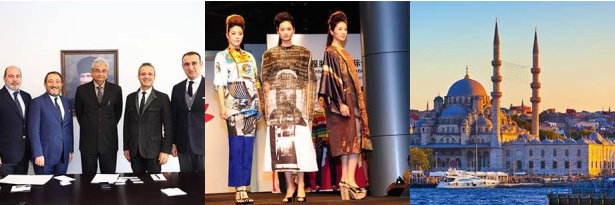
Woven into the conference is the convention’s theme: ‘Making it Better’. For the industry as a whole to really improve, new value must be added and old values implemented. The supply chain session is built around the slogan: ‘Not moving production, but improving production.’ Panelists at the sustainability session will debate on: how the total textile and fashion industrial chain can become a better employer with less negative impact on environment. The ‘emerging brands and emerging markets’ session will show how local Turkish brands have developed into big retail chains. There would also be a session on new entrepreneurs as well as the role of wearable technology.
Istanbul, the perfect platform for convention
Istanbul offers the ideal setting for a convention carrying optimistic message about the development of fashion value chain. It is a great place to network with Turkish manufacturers, and other delegates from over 20 countries. After IAF President Rahul Mehta visited Istanbul to meet Hikmet Tanriverdi, President of the Istanbul Textile and Apparel Exporters Association (IHKIB) and Şeref Fayat, President of the Turkish Clothing Manufacturers' Association (TGSD), he said, “IAF wants to create bridges between continents. We aim to provide maximum value to our members in international cooperation. Manufacturers, retailers, brands, solution providers and associations are working together to improve our industry together. That is why we are hosting this year’s convention in Istanbul, close to the bridge that is literally connecting the continents.”
On October 13 evening, delegates will participate at a gala dinner in the new Raffles Hotel, which is also a part of the Istanbul Fashion Week program. The third day, (October 15) will be devoted to a get-together with the Turkish fashion industry. Companies can sign up for a well guided business to business program.
With the 31st edition of the IAF World Fashion Convention coming to Istanbul, Turkey will be at the center stage of international apparel industry. And as IHKIB President Hikmet Tanriverdi puts it, “We hope to make significant contribution to the world apparel industry.”
Several domestic and foreign-invested cotton projects in Vietnam are rushing to begin operating in anticipation of competition from across borders after the free trade agreements goes into effect. Businesses have sought to invest in cotton production plants in a bid to participate in the industry and increase their competitiveness. Two of the largest FDI projects are trying to build cotton and fiber factories.
Vietnam has called for investment in producing materials for the garment and textile sectors, and to embrace both opportunities and challenges arising from FTAs. In the first five months of the year, the country's imports of cotton and fiber were higher against the same period last year both in terms of quantity and value. However, the country’s exports of these items are also on the rise. There has been a 20 per cent and 5.4 per cent year-on-year rise in quantity and value respectively.
Right now China supplies 60 to 70 per cent of the material used in the country's textile sector. But China is not part of the TPP block. Using Chinese materials for Vietnamese garment and textile products could be a violation of the TPP agreement. It was for this reason that Vietnamese garment and textile firms have hurried to invest in cotton factories.
Italian company Fulgar, a specialised high performance nylon and coated yarn manufacturer has launched a series of innovative fibers. One product is Space 3.0, a special fiber made up three different yarns. When the yarns are dyed they create special melange effects obtained by using a unique controlled and continuous one-step process. This fiber can be used for fashion apparel and sportswear as well as for circular knitwear, hosiery and seamless clothing.
Nanofiber is an innovative yarn composed of seven-micron thick filaments that can be employed for very soft hand and silky-looking items. Q-Skin is a microfiber devised for underwear with anti-bacterial and skin-care properties. Q-Nova is a polyamide 6.6 microfiber made from 99 per cent recycled materials. It aims at reducing CO2 emissions and water consumption while employing energy from renewable sources.
The company produces 35 million tons of nylon 6.6 fiber per year. It has production centers in Sri Lanka and Serbia. It’s an international leader in the synthetic fiber market. It produces polyamide 6.6 and coated elastomers in the textile and technical sectors.
Fulgar is present in all textile sectors (hosiery, circular knits, corsetry, swimming and sport) with high quality products, most of whose are produced in Italy.
www.fulgar.com/


